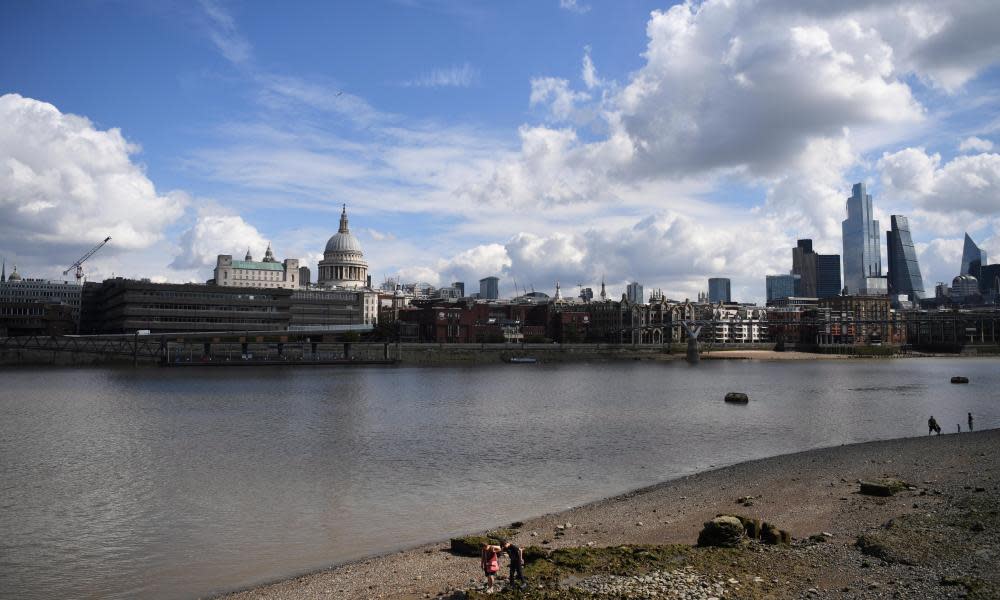Poem of the week: Thames by John Challis

Thames
After a day of keeping tugs and waste disposal barges,
sailing racers, showboats and commuter clippers afloat,
the Thames turns inwardly to find a space
to stretch out in, within a space no bigger than itself,
and burrows through the mud and clay
where every London intersects, to get its nose beneath the grave,
then flips the past up like a coin to send afloat
its drowned possessions: Anglo-Saxon ornaments,
unexploded payloads, bone dice and oyster shells,
wedding rings and number plates, and all those
you might have been had your time started early:
grave-diggers, barrow boys, mole men and cockle pickers,
gong farmers and costermongers, resurrectionists
and suicides; the taken, the lost, the given –
then settles down to dream again of all its infant waterways,
the estuaries and tributaries that led it here,
among the rusted hulls of years, to where there is no space
to breathe or settle down to sleep.
The title of John Challis’s The Resurrectionists alludes to the ancient profession of body-snatching, and the collection is concerned with all kinds of disinterment and revitalisation. In the title poem, the speaker shows us a corpse, filched for experimental resurrection, “jerking on the table / at the dawn of electricity” and asserts: “I too feel the urge to make something / out of nothing and profit from this work: / the page my barrow and my charge the word.” The double meaning of “barrow” is salient: it’s not merely a burial place but a mobile market stall, one of the many images that bring a lost or fading working-class London memorably to life.
The poet-barrow boy delivers a whole river, and a great rumble of activity, in this week’s poem. The area of the Thames Challis says he had roughly in mind was “the stretch from Docklands/Canary Wharf to London Bridge – the main site of London’s industrial past”. On the map, the Thames loops southwards and then north again, possibly narrowing slightly as if, as the poem says, it “turns inwardly to find a space / to stretch out in, within a space no bigger than itself”.
Thames the river is something of a resurrectionist, wanting “to get its nose beneath the grave” – the grave crammed with “every London”, posh and poor, ancient and modern. Artful list-making carries the poem forwards, bobbing and jostling with assorted stuff, from the different, class-denoting vessels in the opening lines to the richly discordant plethora of items that emerges when the river “flips the past up like a coin”. As for “all those / you might have been had your time started early”, the roll call is enlivened by the names of some less than familiar professions – for instance, the night-soil collectors known as “gong farmers” and the “mole men”, a term associated not only with fictional characters but actual tunnel-making engineers.
Related: Poem of the week: Sonnet to Vauxhall by Thomas Hood
There’s a wave-life motion as well as a forwards roll in the poem’s single long sentence, gathering turbulence as the list of the disinterred becomes less specific, perhaps more elegiac – “resurrectionists / and suicides; the taken, the lost, the given”. Still the Thames is searching for a place to rest. But it no sooner settles down to dream of its own past than the clutter swells around it again; it’s caught “among the rusted hulls of years, to where there is no space / to breathe or settle down to sleep”. The personification of the river works unselfconsciously well because the whole rhythm and diction of the poem expresses its physicality, and, beyond the wordsmith’s relish, there is tender sympathy for the river’s plight.
The Resurrectionists by John Challis is published by Bloodaxe Books. Catch up with the poet reading in a joint online book launch here.

 Yahoo Movies
Yahoo Movies 
